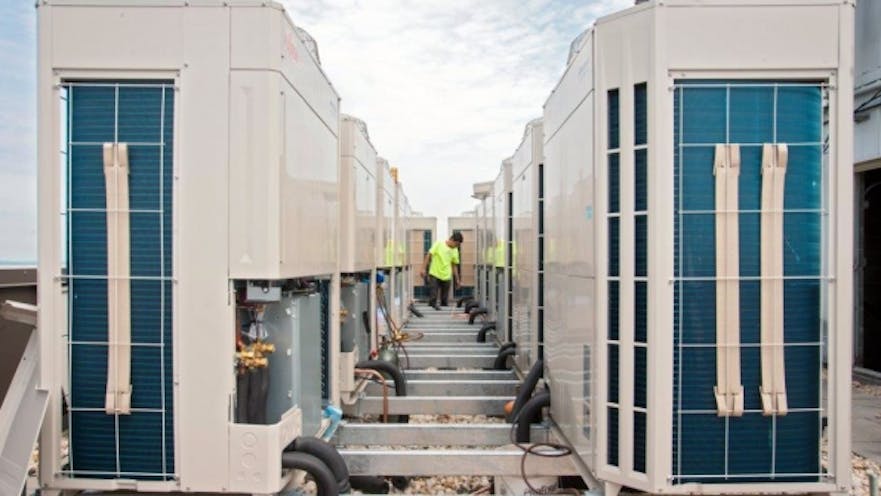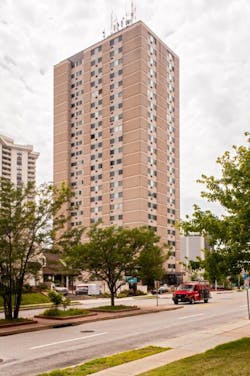Packaged terminal air conditioners (PTAC) have long filled the need for a combined heating and cooling solution that provides low upfront cost, individual control and stand-alone operation within a relatively small footprint. Once installed, PTACs also make the replacement process simple down the road. That’s why making a case for an alternative to the PTAC on a high-rise building retrofit can be a challenge.
Starting in 2014, my company, Melling Engineering, joined several other firms to do just that during an upcoming renovation of Tabco Towers, a large HUD (Housing and Urban Development) apartment building in Towson, MD. The project culminated in late 2016, and so far, has exceeded every expectation.
The building’s owner, Wishrock Investment Group, had been planning HVAC and building upgrades at the high-rise for some time. After Wishrock consulted with New Ecology, a non-profit sustainability consulting firm with offices in Boston, Providence, Hartford and Baltimore, they decided to pursue 2011 Enterprise Green Communities (EGC) certification.
“EGC certification is based on a number of factors, including a building’s energy performance,” said Marty Davey, Director of Portfolio Services at New Ecology, who has worked on other Wishrock projects in the past. “Building to this certification opens the door to significant funding in Maryland.”
In addition to certification and efficiency, Wishrock was looking for a longer-term solution that would provide greater comfort, control and reduced maintenance costs. Because the wall penetrations for the PTAC units had caused maintenance issues in recent years, sealing up the building and controlling condensate drainage were goals as well.
Finding the Right Replacement
While New Ecology gathered building performance data, created an energy model of the building, and helped define the overall “greening” goals of the project, we were brought onboard. Based in Raleigh, NC, we’re an MEP firm that specializes in apartment buildings, apartment communities, and commercial space. That work often comes through collaboration with several architects across the East Coast.
Once a performance baseline for the 22-story building was established, the first challenge became selecting a replacement HVAC system. More efficient PTACs were considered, but the performance levels needed just weren’t available. As a high-efficiency, long-term solution, water-source heat pumps (WSHP) would have worked well but without the need to individually monitor energy use across all the apartments, it was hard to justify the extensive core drilling necessary to install the system.
The use of mini-split heat pumps as a one-for-one replacement for the existing PTACs was also extensively discussed. Efficiency levels were on par with what we needed to achieve, but with 200 apartments in a 180-foot building, finding a place to install all the condensers was difficult. Further, it required too many wall penetrations, and most mini-split systems could not accommodate the line-set lengths that would’ve been needed.
Eventually, we began to consider a central VRF (Variable Refrigerant Flow) system. Like the WSHPs, our initial skepticism concerning VRF at Tabco Towers was the higher upfront cost.
What ultimately tipped the scales in favor of VRF was that the retrofit needed to take place while the building was completely occupied. Melling Engineering routinely designs both VRF and WSHP systems, but we’ve never used VRF to replace a PTAC system, let alone in a low-income apartment building. It was ultimately the work of Marty Davey and the team at New Ecology that made it possible. In addition to an energy audit and modeling, they secured the funding that would take the project from a 15-year payback down to a five- or six-year return.
200 Tons
Earlier, when mini-split heat pumps were still part of the discussion, the design team had looked closely at Fujitsu units based on a discussion that New Ecology’s Jonah Decola had with a Fujitsu Sales Engineer at the AHR Show in Chicago. We spoke with Fujitsu again when the focus shifted to VRF, and had good factory support throughout the design. But we needed to look at other manufacturers as well, considering the many criteria the new system would need to meet. Fujitsu’s Airstage heat recovery system remained the number one choice because of its overall efficiency. In addition, the Fujitsu RBUs (refrigerant branch units) fit in the small spaces allotted to us.
We initially looked at both heat pump-only and heat-recovery systems. But the building’s shape – tall and slender – meant that most of the rooms have external walls and windows. This creates the potential for widely varying loads, and increases the likelihood of different zones simultaneously calling for heat and cooling. Being able to essentially “recycle” heat, or extracting heat from one space and rejecting into another zone on the same system was a big advantage, especially during the shoulder seasons.
Before plans were finalized, the general contractor, Ellisdale Construction and Development, was brought onboard. The Integrated Companies, a large mechanical contractor out of Chantilly, VA, took the bid to do equipment installation. Both firms are known for their work in hi-rise apartment buildings and had the design and engineering capacity to pull it off. Their help was invaluable.
The final plan utilized 22 VRF condensers, most of which were 10-tons each. The units were paired together into 20-ton systems, with one system serving two floors. All but two systems were placed on the roof. Apartments on the first and second floor are served by a ground-mounted system, while common areas in the basement and first floors use a four-ton Fujitsu JII single phase VRF system, also located at grade.
Installation Headwinds
Work started in February of 2016. Integrated technicians worked their way up the tower, one floor at a time. One-bedroom apartments were outfitted with an 18,000 BTU slim-duct unit that was enclosed in a new soffit with an access panel. This required that the existing sprinkler system in the area and in the adjacent bedroom closet be reworked to provide room for the unit and ductwork. The studio apartments are conditioned by a wall-mount evaporator. Depending on the size of the apartment, these range from 9,000 to 14,000 BTU. The PTAC units remained in service for the duration of the project. Without interrupting either the heating or cooling in any apartments, tenants were only displaced for several hours.
“Being an occupied, existing building with limited space, we were tasked with the challenge of finding a location for the RBUs,” said Scottie Williams, CEO at Integrated. “We efficiently prepared and strategized the most effective way to use our minimal space within the units and ceiling space. We achieved a solution by utilizing the smaller electrical closets and a few apartment closets to install four RBUs per floor.”
On each floor, there are two, four-branch RBUs and two single-branch RBUs. Unlike a mini-split system, the use of the RBUs with heat-recovery condensing units not only allows the system to supply simultaneous heating and cooling, but also to share refrigerant between two evaporators. If one room is calling for heat, and another on the same floor is in cooling mode, the cooling unit can effectively reject heat into the room calling for heat.
Line-sets from the roof were run down through an old common exhaust vent. As part of the retrofit project, Ellisdale installed bathroom exhaust fans in each restroom, abandoning the old common exhaust duct and availing it to serve as a chase for the mechanical system. In addition to line-sets, the vent was used to run new power lines to the roof. After the Airstage condensers were craned to the roof, Integrated technicians placed them on top of a custom-made framework on both sides of the elevator tower. A single, 48,000 BTU Fujitsu Halcyon unit was also used to help condition the upper portion of the elevator shaft. Despite the scope of the project and several challenges, system start-up began in late July. Work on the mechanical system culminated in October.
Certification and ROI
“As planned, this project progressed efficiently with the assistance of Ellisdale Construction, the Engineer of Record, Craig Howell and Matt Cole of the Ferguson VRF Division, and Fujitsu,” said Williams.
Communication between all parties involved was outstanding. But New Ecology was definitely the impetus of the project. Without their work before and during the install, providing such an efficient, comfortable solution in an older building on a tight budget simply wouldn’t have been an option.
“At New Ecology, we perform comprehensive audits with payback analysis, to help owners make decisions,” said Davey. “In simple numbers, modeling showed that the VRF retrofit at Tabco Towers would yield a 15-year payback before any subsidy or grant money is accounted for. After receiving funding based on the criteria in Enterprise Green Communities Certification, the real return on investment might be about five or six years. That said, we perform robust post-project analyses for every project we’re involved with, tracking building performance for years to make sure it stays on track and to deepen our understanding.”
The hope is that Tabco Towers can serve as a template for similar projects across the country, especially as redevelopment requirements set higher energy efficiency standards. For Melling Engineering, we’re adding the experience to our portfolio to prove that, in certain situations, there is a viable alternative to exchanging PTACs in a hi-rise.
Rick Melling is president, Melling Engineering, PC, based in Raleigh, N.C. The firm has been providing mechanical, electrical, plumbing, and fire alarm engineering design for commercial buildings for 20 years.









